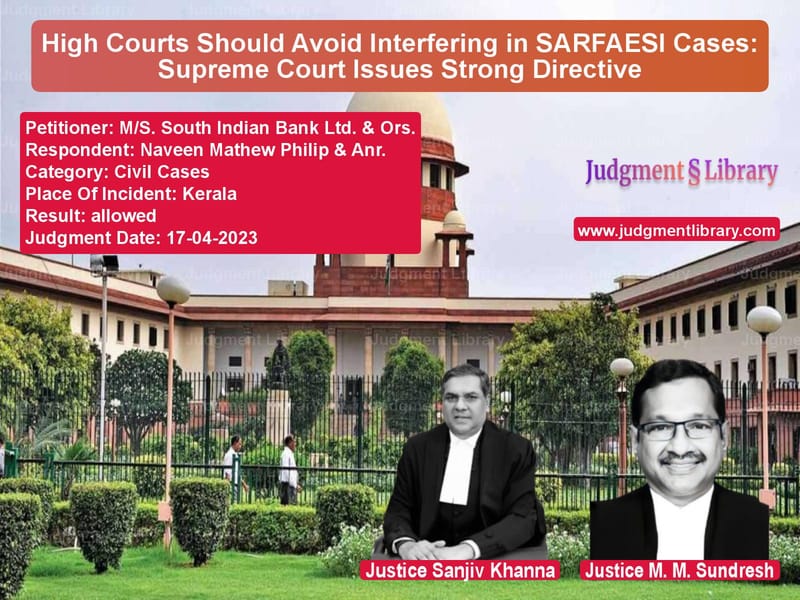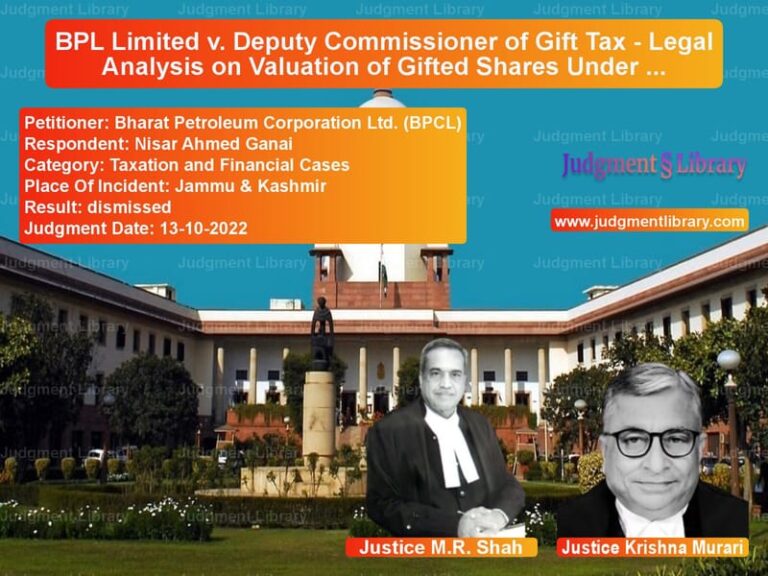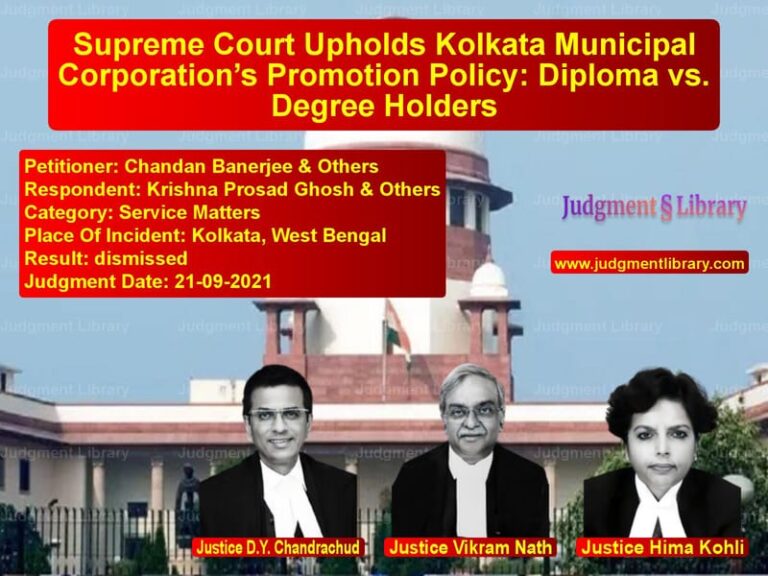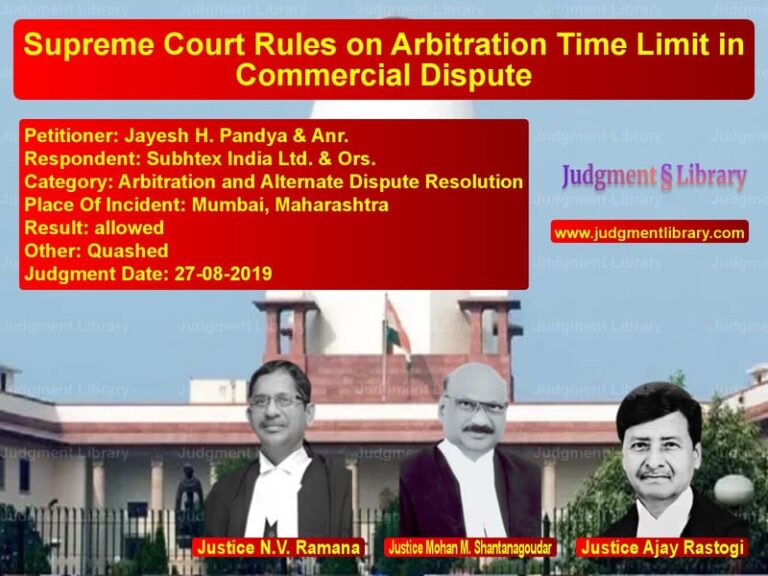High Courts Should Avoid Interfering in SARFAESI Cases: Supreme Court Issues Strong Directive
The Supreme Court of India has reiterated that High Courts should refrain from entertaining writ petitions under Article 226 in matters related to the Securitization and Reconstruction of Financial Assets and Enforcement of Security Interest Act, 2002 (SARFAESI Act). The ruling, delivered in the case M/S. South Indian Bank Ltd. & Ors. vs. Naveen Mathew Philip & Anr., highlights the need to direct financial disputes to the specialized tribunals established under the SARFAESI Act instead of burdening constitutional courts.
Background of the Case
The case involved two loans availed by the respondents, which were classified as Non-Performing Assets (NPA) on May 27, 2021. Subsequently, the bank issued notices under Section 13(2) of the SARFAESI Act in August 2021, demanding repayment.
The respondents replied to the notices on October 28, 2021, requesting 12 months to repay the loan. However, just three days later, they challenged the bank’s demand notice by filing a writ petition before the Kerala High Court. The High Court intervened and directed the bank to consider the respondents’ proposal for repayment.
The respondents failed to meet their revised repayment commitments, leading to the issuance of possession notices under Section 13(4) of the SARFAESI Act in December 2021. The borrowers then filed fresh writ petitions before the High Court, challenging the bank’s actions.
Key Legal Issues
The Supreme Court examined the following questions:
- Can High Courts entertain writ petitions related to SARFAESI proceedings despite the availability of statutory remedies?
- Should High Courts allow borrowers to challenge loan recovery actions under Article 226?
- Did the Kerala High Court err in granting installment-based relief to borrowers outside the scope of the SARFAESI Act?
Arguments by the Appellants (South Indian Bank & Others)
The bank contended that:
- Alternative Remedy Exists: The SARFAESI Act provides a well-defined mechanism for borrowers to challenge loan recovery actions, including filing appeals before the Debt Recovery Tribunal (DRT) and Debt Recovery Appellate Tribunal (DRAT).
- Judicial Interference Delays Recovery: The repeated intervention of High Courts in such cases has slowed down the enforcement of recovery proceedings, defeating the very purpose of the SARFAESI Act.
- High Courts Are Overstepping Their Jurisdiction: The High Court not only intervened in the bank’s loan recovery efforts but also granted relief to the borrowers by allowing them to repay in 20 installments, a benefit not even requested by the borrowers.
- Massive Pendency of SARFAESI-Related Writ Petitions: The bank cited that the Kerala High Court alone had entertained over 185 writ petitions challenging SARFAESI actions, with 35 more filed after the Supreme Court’s notice.
Arguments by the Respondents (Borrowers)
The borrowers argued that:
- No Functional Tribunal at the Time: At the time of filing their writ petitions, the DRT was not operational due to the absence of a presiding officer.
- High Court’s Powers Under Article 226 Remain Intact: The power of High Courts to intervene in cases of financial hardship and procedural lapses remains valid despite the existence of alternative remedies.
- Extreme Steps Taken by Banks Justify Writ Petitions: Borrowers often have no other option but to approach High Courts when banks resort to aggressive recovery measures.
Supreme Court’s Verdict
1. High Courts Must Not Intervene in SARFAESI Matters
The Court reaffirmed that High Courts should refrain from entertaining writ petitions related to SARFAESI disputes when an effective statutory remedy is available, stating:
“We are also constrained to take judicial notice of the fact that certain High Courts continue to interfere in such matters, leading to a regular supply of cases before this Court. One such High Court is that of Punjab & Haryana.”
2. SARFAESI Provides an Adequate Remedy
The Court ruled that borrowers must exhaust the remedies provided under the SARFAESI Act before invoking writ jurisdiction, citing the landmark judgment in United Bank of India vs. Satyawati Tondon (2010), which held:
“The High Court must insist that before availing remedy under Article 226 of the Constitution, a person must exhaust the remedies available under the relevant statute.”
3. Financial Institutions Must Not Be Burdened by Delays
The Court criticized the practice of borrowers filing writ petitions to delay loan recoveries and directed banks to be allowed to proceed with recovery measures without unnecessary judicial interference.
4. The Kerala High Court Overstepped Its Jurisdiction
The Supreme Court held that the Kerala High Court erred in granting relief to the borrowers by allowing deferred payment of loan dues in installments, which went beyond the statutory framework.
Key Excerpt from the Judgment
In a strong warning against judicial overreach, the Supreme Court observed:
“The present appeals are disposed of. The Registry is directed to mark a copy of this order to the High Court of Kerala and the High Court of Punjab & Haryana.”
Conclusion
The Supreme Court’s ruling in this case serves as a clear directive to High Courts across India to avoid interfering in SARFAESI-related disputes when alternative remedies exist. The decision reinforces the legal principle that financial matters should be resolved within the statutory framework provided under the SARFAESI Act, rather than through writ jurisdiction.
The judgment will have far-reaching implications, ensuring that banks and financial institutions can expedite loan recoveries without undue judicial intervention while providing borrowers with clear legal pathways to challenge any wrongful actions.
Petitioner Name: M/S. South Indian Bank Ltd. & Ors..Respondent Name: Naveen Mathew Philip & Anr..Judgment By: Justice Sanjiv Khanna, Justice M. M. Sundresh.Place Of Incident: Kerala.Judgment Date: 17-04-2023.
Don’t miss out on the full details! Download the complete judgment in PDF format below and gain valuable insights instantly!
Download Judgment: ms.-south-indian-ba-vs-naveen-mathew-philip-supreme-court-of-india-judgment-dated-17-04-2023.pdf
Directly Download Judgment: Directly download this Judgment
See all petitions in Debt Recovery
See all petitions in Banking Regulations
See all petitions in Contract Disputes
See all petitions in Judgment by Sanjiv Khanna
See all petitions in Judgment by M.M. Sundresh
See all petitions in allowed
See all petitions in supreme court of India judgments April 2023
See all petitions in 2023 judgments
See all posts in Civil Cases Category
See all allowed petitions in Civil Cases Category
See all Dismissed petitions in Civil Cases Category
See all partially allowed petitions in Civil Cases Category







